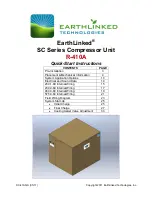
7
A convenient method to indicate the above relationship is to
use a metal scribe to mark the parts with numbers or lines.
Do not use a marking method that can be wiped off or
obliterated during rebuilding, such as chalk. Remove all
compressor attachments such as governors, air strainers
or inlet fittings, discharge fittings and pipe plugs.
Cylinder Head
Remove the six cylinder head cap screws and tap the head
with a soft mallet to break the gasket seal. Remove the inlet
valve springs from the head and inlet valves from their guides
in the crankcase. Remove inlet valve guides from around
the inlet valve seats on the crankcase taking care not to
damage seats. Scrape off any gasket material from the
cylinder head and crankcase. Unscrew the discharge valve
seats from the head and remove the discharge valves and
springs. Inspect the discharge valve seats for nicks, cracks,
and excessive wear and replace if necessary.
The discharge valve stops should be inspected for wear
and replaced if excessive peening has occurred. To
determine if excessive peening has occurred, measure the
discharge valve travel. Discharge valve travel must not exceed
.057 inches. To remove the discharge valve stops, support
the machined surface of the cylinder head on an arbor press
bed and gently press the stops from the top of the head and
out the bottom. Be sure to allow sufficient clearance for the
stops between the press bed and the bottom of the cylinder
head. The valve stop bores in the cylinder head must be
inspected for excessive scoring. A new head body must be
used if scoring is excessive. Discard the inlet valves and
springs, the discharge valves and springs and the discharge
valve seats if defective.
Crankcase Base Plate or Adapter
Remove the cap screws securing the base plate or base
adapter. Tap with soft mallet to break the gasket seal. Scrape
off any gasket material from crankcase and plate or adapter.
Connecting Rod Assemblies
(Note:
Before removing the connecting rods, mark each
connecting rod and its cap. Each connecting rod is
matched to its own cap for proper bearing fit, and
these parts must not be interchanged.)
Straighten the prongs of the connecting rod bolt lock strap
and remove the bolts and bearing caps. Push the piston
with the connecting rods attached out the top of the cylinders
of the crankcase. Replace the bearing caps on their
respective connecting rods. Remove the piston rings from
the pistons. If the pistons are to be removed from the
connecting rods, remove the wrist pin lock wires or teflon
plugs and press the wrist pins from the pistons and
connecting rods.
If the pistons are removed from the rod, inspect the bronze
wrist pin bushing. Press out and replace the bushing if it is
excessively worn. (See inspection of Parts) Discard the
piston rings and the connecting rod journal bearings.
Discard the wrist pin bushings if they were removed.
Crankcase
Remove the key or keys from the crankshaft and any burrs
from the crankshaft where the key or keys were removed.
(Note:
Through Drive Compressors may have a crankshaft
key at both ends.)
Remove the four cap screws securing front or drive-end end
cover or flange adapter. Remove the end cover, taking care
not to damage the crankshaft oil seal or front main bearing,
if any. Remove both of the small seal rings from the
crankcase, and the o-ring from around the front end cover.
Remove the four cap screws securing the rear end cover
and remove the rear end cover taking care not to damage
the rear main bearing, if any. Remove both of the small seal
rings from the crankcase and the o-ring from around the end
cover. If the compressor has ball type main bearings, press
the crankshaft and ball bearings from the crankcase, then
press the ball bearings from the crankshaft. Remove the
unloader spring, spring saddle, and spring seat from the
inlet cavity of the crankcase, using long nose pliers. Remove
the unloader plungers and guides. Cover the inlet cavity with
a shop rag and apply air pressure to the governor mounting
pad unloader port to blow the unloader pistons out of their
bores and into the inlet cavity.
CLEANING OF PARTS
General
All parts should be cleaned in a good commercial grade
solvent and dried prior to inspection.
Cylinder Head
Remove all the carbon deposits from the discharge cavities
and all the rust and scale from the cooling cavities of the
cylinder head body. Scrape all the foreign matter from the
body surfaces and use shop air pressure to blow the dirt
particles from all the cavities.
Crankcase
Clean the carbon and dirt from the inlet and unloader
passages. Use shop air pressure to blow the carbon and
dirt deposits from the unloader passages.
Oil Passages
Thoroughly clean all oil passages through the crankshaft,
crankcase, end covers, and base plate or base adapter.
Inspect the passages with a wire to be sure. Blow the
loosened foreign matter out with air pressure.
Summary of Contents for TU-FLO 501
Page 28: ...28 NOTES ...
Page 35: ...35 ...








































